
Ara the Handsome[1][2] (Armenian: Արա Գեղեցիկ, romanized: Ara Gełec‘ik) is a semi-legendary Armenian hero and king. Ara is notable in Armenian literature for the popular legend in which he was so handsome that the Assyrian queen Semiramis waged war against Armenia to capture him and bring him back to her, alive.
Ara is sometimes associated Arame of Urartu, who ruled the Kingdom of Urartu Biainili during the 9th century BC.
Genealogy
In Movses Khorenatsi's History of Armenia, Ara the Handsome is presented as the son of Aram and a descendant of Hayk, the legendary forefather of the Armenians.[3] Khorenatsi writes that Ara the Handsome had a son, also named Ara, by his wife, Nuard (Nvard). Ara, son of Ara, who was twelve years old at the time of his father's death, was appointed ruler of Armenia by Semiramis and later died in a war against her.[4]
Legend
According to the legend, Semiramis (Shamiram in Armenian) had fallen in love with the handsome Armenian King and asked him to marry her. When Ara refused, Semiramis, in the heat of passion, gathered the armies of Assyria and marched against Armenia. During the battle Semiramis was victorious, but Ara was slain despite her orders to capture him alive. To avoid continuous warfare with the Armenians, Semiramis, reputed to be a sorceress, took his body and prayed to the gods to raise Ara from the dead. When the Armenians advanced to avenge their leader, Semiramis disguised one of her lovers as Ara and spread the rumor that the gods had brought Ara back to life, convincing the Armenians not to continue the war.[5][6] In one persistent tradition, Semiramis' prayers are successful and Ara returns to life.[5][7] During the 19th century, it was also reported that a village called Lezk, near Van, traditionally held that it was Ara's place of resurrection.[5]
Connection to Plato's Myth of Er
Scholars have connected the story of Ara the Handsome to the Myth of Er, told in Plato's Republic (10.614–10.621).[8] The story begins as a man named Er (/ɜːr/; Greek: Ἤρ, gen.: Ἠρός), son of Armenios (Ἀρμένιος), of Pamphylia dies in battle. When the bodies of those who died in the battle are collected, ten days after his death, Er remains undecomposed. Two days later he revives on his funeral-pyre and tells others of his journey in the afterlife, including an account of reincarnation and the celestial spheres of the astral plane. The tale includes the idea that moral people are rewarded and immoral people punished after death.
Armen Petrosyan suggests that Plato's version reflects an earlier form of the story where Er (Ara) rises from the grave.[8]
See also
References
- ↑ Petrosyan 2002, p. 78.
- ↑ Petrosyan 2015, p. 46.
- ↑ Petrosyan 2007, p. 299.
- ↑ Moses Khorenatsʻi (1978). "Genealogy of Greater Armenia". History of the Armenians. Translated by Thomson, Robert W. Cambridge, Massachusetts: Harvard University Press. p. 107. ISBN 0-674-39571-9.
- 1 2 3 Agop Jack Hacikyan (2000). The Heritage of Armenian Literature: From the oral tradition to the Golden Age. Wayne State University Press. pp. 37–8. ISBN 0-8143-2815-6.
- ↑ Louis A. Boettiger (1918). "2". Studies in the Social Sciences: Armenian Legends and Festivals. Vol. 14. The University of Minnesota. pp. 10–11.
- ↑ M. Chahin (2001). The Kingdom of Armenia: A History. Psychology Press. pp. 74–5. ISBN 978-0-7007-1452-0.
- 1 2 Petrosyan, Armen. The Indo-European and Ancient Near Eastern Sources of the Armenian Epic (2002) pp. 88.
Bibliography
- Ahyan, Stepan (1982). "Les débuts de l'histoire d'Arménie et les trois fonctions indo-européennes". Revue de l'histoire des religions. 199 (3): 251–271. doi:10.3406/rhr.1982.4670.
- Petrosyan, Armen (2002), The Indo‑european and Ancient Near Eastern Sources of the Armenian Epic, Washington, D.C: Institute for the Study of Man, ISBN 9780941694810
- Petrosyan, Armen (2007). "The Indo-European *H2ner(t)-s and the Danu Tribe". Journal of Indo-European Studies. 35: 297–310. ISSN 0092-2323.
- Petrosyan, Armen (2012). "Armenia and Ireland: Myths of Prehistory". Ireland and Armenia: Studies in Language, History and Narrative. Washington, D.C: Institute for the Study of Man. pp. 113–131. ISBN 9780984538386.
- Petrosyan, Armen (2015). Problems of Armenian Prehistory. Myth, Language, History. Yerevan: Gitutyun. ISBN 9785808012011.
- Matikian, Alexander (1930), Արայ Գեղեցիկի [Aray the Handsome] (in Armenian), Vienna
{{citation}}: CS1 maint: location missing publisher (link) - Kapancyan, Grigor (1944), Արա Գեղեցիկի պաշտամունքը [The Worship of Ara the Handsome] (in Armenian), Yerevan: Academy of Sciences
- Russell, J. R. (1985). "ARA THE BEAUTIFUL". In Yarshater, Ehsan (ed.). Encyclopædia Iranica, Volume II/2: Anthropology–ʿArab Moḥammad. London and New York: Routledge & Kegan Paul. p. 200. ISBN 978-0-71009-102-4.
- Ter-Ghevondian A. N. (1965). ""Արա և Շամիրամ" առասպելի մի արձագանքը արաբ պատմիչ Մասուդու մոտ [The Echo of the Legend "Ara and Semiramides" in the Arab Historian Masudi]". Patma-Banasirakan Handes (in Armenian). № 4: 249–253. ISSN 0135-0536.